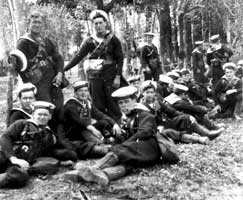 Over the last four decades of the 19th Century, Royal Navy Sea Service Accoutrements had been steadily evolving without ever acquiring a specific pattern date. (Victorian Sea Service Accoutrements will be the subject of a future upload to KW), With the dawn of the 20th Century the RN finally followed Army practice and gave their newest accoutrements a pattern year.
Over the last four decades of the 19th Century, Royal Navy Sea Service Accoutrements had been steadily evolving without ever acquiring a specific pattern date. (Victorian Sea Service Accoutrements will be the subject of a future upload to KW), With the dawn of the 20th Century the RN finally followed Army practice and gave their newest accoutrements a pattern year.
The Accoutrements, naval, pattern 1901 were approved on 8 August 1901 and announced by List of Changes § 11110 of 1st July 1902. They were to be made of thinner leather of a darker shade than the previous accoutrements.
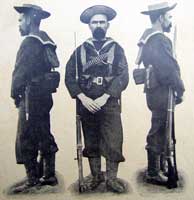 The reasons that initiated the development of the Accoutrements, naval, pattern 1901 are currently unknown but given the simpler design using thinner leather, cost cutting was no doubt a contributing factor. Similarly when development was started is also unknown, but it was certainly well underway by 1st March 1900 when the front cover of the periodical “Under the Union Jack” depicted three classic views of a sailor wearing what is clearly equipment that would eventually evolve into the pattern 1901. While the basic design is there, the water bottle carriage & cartridge carrier were still heavily influenced by those of the then current pattern and the haversack was clearly impractical and was destined to be redesigned. Interestingly, at least one of the same photos, with a different background, appeared as part of a series of postcards entitled “The Backbone of the Navy”. Another card in the “Backbone” series depicts a sailor, this time with the equipment set up for pistol & cutlass and once again showing the “trials” haversack. Nothing is currently known concerning the extent or results of any trials of the new equipment, but the information may well be laying a UK archive somewhere waiting to be discovered.
The reasons that initiated the development of the Accoutrements, naval, pattern 1901 are currently unknown but given the simpler design using thinner leather, cost cutting was no doubt a contributing factor. Similarly when development was started is also unknown, but it was certainly well underway by 1st March 1900 when the front cover of the periodical “Under the Union Jack” depicted three classic views of a sailor wearing what is clearly equipment that would eventually evolve into the pattern 1901. While the basic design is there, the water bottle carriage & cartridge carrier were still heavily influenced by those of the then current pattern and the haversack was clearly impractical and was destined to be redesigned. Interestingly, at least one of the same photos, with a different background, appeared as part of a series of postcards entitled “The Backbone of the Navy”. Another card in the “Backbone” series depicts a sailor, this time with the equipment set up for pistol & cutlass and once again showing the “trials” haversack. Nothing is currently known concerning the extent or results of any trials of the new equipment, but the information may well be laying a UK archive somewhere waiting to be discovered.
Click HERE for Rog Dennis’s in-depth analysis of that equipment.
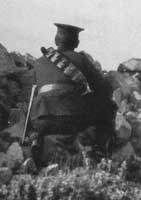 Accoutrements, naval, pattern 1901 introduced some innovative thinking for ammunition carriage, but had abandoned a better idea, a belt-mounted Water bottle carrier, which would not be seen again until the Australians modified their Pattern 1937 W.E. for the jungle campaigns in the Second World War. The Braces that were more French style in their method of adjustment than anything seen in British service before or since, and were also permanently linked, a feature not seen in the British Army until Pattern 1944 W.E. was introduced. Naval Brace Equipment had provided Blanket Carriages, but the Accoutrements, naval, pattern 1901 were more a Battle Order pattern, which obviated the need for Carriages. In the 1909 edition of Rifle and Field Exercises for His Majesty’s Fleet Part XII Accoutrements for Seamen, mentions that the “…kitbag and waterproof sheet are intended to be carried by transport, but the former can be carried by hand or over the shoulders…”1. Another innovation was the Bandolier, fitted to accommodate .303-in. ammunition in chargers. This was two years ahead of the Army adopting Pattern 1903 Bandolier Equipment, whose Bandoliers may well have been inspired by the Navy’s version. In the end only the Sling, rifle and the Becket, sword were carried over from earlier patterns and simply redesignated as pattern 1901 while the heritage of the Belt, waist was still clearly identifiable to anyone familiar with the 19th Century Accoutrements.
Accoutrements, naval, pattern 1901 introduced some innovative thinking for ammunition carriage, but had abandoned a better idea, a belt-mounted Water bottle carrier, which would not be seen again until the Australians modified their Pattern 1937 W.E. for the jungle campaigns in the Second World War. The Braces that were more French style in their method of adjustment than anything seen in British service before or since, and were also permanently linked, a feature not seen in the British Army until Pattern 1944 W.E. was introduced. Naval Brace Equipment had provided Blanket Carriages, but the Accoutrements, naval, pattern 1901 were more a Battle Order pattern, which obviated the need for Carriages. In the 1909 edition of Rifle and Field Exercises for His Majesty’s Fleet Part XII Accoutrements for Seamen, mentions that the “…kitbag and waterproof sheet are intended to be carried by transport, but the former can be carried by hand or over the shoulders…”1. Another innovation was the Bandolier, fitted to accommodate .303-in. ammunition in chargers. This was two years ahead of the Army adopting Pattern 1903 Bandolier Equipment, whose Bandoliers may well have been inspired by the Navy’s version. In the end only the Sling, rifle and the Becket, sword were carried over from earlier patterns and simply redesignated as pattern 1901 while the heritage of the Belt, waist was still clearly identifiable to anyone familiar with the 19th Century Accoutrements.
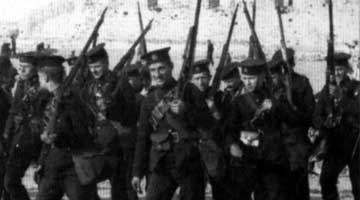
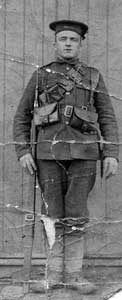 Once approved on the 8th August 1901 production of the Accoutrements commences almost immediately, even before the Specifications were approved or the List of Changes announcement made. Surviving examples indicate that significant production took place from 1901 to 1904 inclusive then becoming somewhat sporadic in the years leading up to the Great War before commencing in earnest again, in 1913. No items produced between the Wars have been noted, but significant production again took place over the years 1940 to 42. The Second World War production seems to be largely, but not entirely, restricted to Revolver Accoutrements. Production was also undertaken in Australia & Canada during the Great War period. (See separate sections.)
Once approved on the 8th August 1901 production of the Accoutrements commences almost immediately, even before the Specifications were approved or the List of Changes announcement made. Surviving examples indicate that significant production took place from 1901 to 1904 inclusive then becoming somewhat sporadic in the years leading up to the Great War before commencing in earnest again, in 1913. No items produced between the Wars have been noted, but significant production again took place over the years 1940 to 42. The Second World War production seems to be largely, but not entirely, restricted to Revolver Accoutrements. Production was also undertaken in Australia & Canada during the Great War period. (See separate sections.)
While no documents specifically relating to Royal Navy scales of issue for the Accoutrements, naval, pattern 1901 have been located by the KWRT, it can be assumed from the scale of issue of the Patterns 1908 and 1919 Web Equipments that replaced it, that the Accoutrements were issued at the rate of one set per rifle or pistol. For example, a battle-cruiser carried 90 pistols, while a light cruiser carried 50 & a torpedo boat destroyer only 202, so that would be 90, 50 & 20 sets of pistol Accoutrements respectively.
The Accoutrements, naval, pattern 1901 augmented rather than replaced the earlier pattern. Even so, there has been no photographic or documentary evidence come to light to suggest that components of the two patterns were ever mixed. The Accoutrements, naval, pattern 1901 were issued to the Fleet and initially, in the early days of the Great War, to elements of the RND and RM.
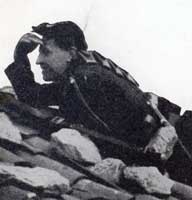 By 1919 the decision had been taken to re-equip the Fleet with Web Equipment Patterns 1908 and 1919 and CMO 867/193 (yet to be sighted by KW) gave the allocations. By 1922 the process was well underway with AFO 828/22 & 2545/22 directing that Equipment of other patterns be returned to store on receipt of Web Equipment. AFO 2546/22, however, gave the Pattern 1901 pistol accoutrements a short reprieve due to the supply of Pattern 1919 Web Equipment not being available until later in the year. Nothing is known of their use though the rest of the 20’s and 30’s or the story behind theWorld War production, but by 1943, AFO 5604/43 stated that auxiliary vessels were, in future, to be supplied with web equipment Pattern 1937 in lieu of leather accoutrements, Pattern 1901. This is the last mention of Accoutrements, naval, pattern 1901 the KWRT have located. Research is ongoing; if you can fill in any gaps, please let us know.
By 1919 the decision had been taken to re-equip the Fleet with Web Equipment Patterns 1908 and 1919 and CMO 867/193 (yet to be sighted by KW) gave the allocations. By 1922 the process was well underway with AFO 828/22 & 2545/22 directing that Equipment of other patterns be returned to store on receipt of Web Equipment. AFO 2546/22, however, gave the Pattern 1901 pistol accoutrements a short reprieve due to the supply of Pattern 1919 Web Equipment not being available until later in the year. Nothing is known of their use though the rest of the 20’s and 30’s or the story behind theWorld War production, but by 1943, AFO 5604/43 stated that auxiliary vessels were, in future, to be supplied with web equipment Pattern 1937 in lieu of leather accoutrements, Pattern 1901. This is the last mention of Accoutrements, naval, pattern 1901 the KWRT have located. Research is ongoing; if you can fill in any gaps, please let us know.
Most photographs of the Accoutrements, naval, pattern 1901 in use date from the Great War period or shortly thereafter. One thing that is evident in many photos is the disregard for the fitting instructions, particularly in relation to the Braces where they are often incorrectly attached or not used at all!
Footnotes:
1. Note 9 on P. 245 of R&FE 1909.
2. Calculated from information in National Archives of Australia file MP472/1 819358 Small arms accoutrements for HMA Ships, adoption of Webley Scott Automatic pistol.
3. CMO 867/19 is referred to in several subsequent AFO’s hence we know of its existence.
Graham Tweeddale 2011